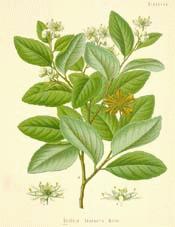

|
Soapbark
(Quillaja saponaria Mol.)
|
Soap Tree
Botanical: Quillaja saponaria (MOLINA.)
Family: N.O. Rosaceae
---Synonyms---Soap Bark. Panama Bark. Cullay.
---Part Used---Dried inner bark.
---Habitat---Peru and Chile, and cultivated in Northern Hindustan.
---Description---A tree 50 to 60 feet high. Leaves smooth, shiny, short-stalked, oval, and usually terminal white flowers, solitary, or three to five on a stalk. Bark thick, dark coloured, and very tough. In commerce it is found in large flat pieces 1/5 inch thick, outer surface brownish-white, with small patches of brownish cork attached, otherwise smooth; inner surface whitish and smooth, fracture splintery, chequered with pale-brown vast fibres, embedded with white tissue; it is inodorous, very acrid and astringent.
---Constituents---Its chief constituent is saponin, which is a mixture of two glucosides, guillaic acid and guillaia-sapotoxin. The latter is very poisonous and possesses marked foam-producing properties. Calcium oxalate is also present in the bark. The drug also contains cane-sugar and a non-toxic modification of guillaic acid. As the active principles of Soap Bark are the same as those of Senega, Quillaia has been suggested as a cheap substitute for Sarsaparilla.
---Medicinal Action and Uses---It can be used as a stimulating expectorant. As a decoction (5 parts to 200), adult-dose 1 tablespoonful. Syrup of guillaia can be utilized as a substitute for syrup of Senega, by adding 4 parts of the fluid extract to 21 parts of syrup, using diluted alcohol as the menstruum.
[Top]
---Doses of Quillaia Bark---Fluid extract, 2 to 8 drops. Solid extract, 1/2 to 2 grains. Tincture, B.P. and U.S.P., 1/2 to 1 drachm.
Might be useful in cases of aortic disease with hypertrophy, its efficacy depending on the dimmished action of the cardiac ganglia and muscle which its active principle, Saponine, produces. Saponin appears to be identical with Cyclamin, from Cyclamen European, and with primulin from Primula officinalis. Digitonin from Digitalis appears to be a kind of Saponin differing somewhat from the others. Saponin, when applied locally, is a powerful irritant, local anaesthetic and muscular poison. On account of its local irritation, when injected hypodermically it causes intense pain; sneezing when applied to the nose; vomiting, diarrhoea and gastroenteritis if taken in large doses internally. Locally applied, it paralyses motor and sensory nerves, and voluntary and involuntary muscular fibre; in the voluntary muscles it produces a condition of rigor mortis, and the muscular substance becomes brittle and structureless. Saponin acts as an emetocathartic and a diuretic if it is absorbed; in its excretion it irritates the bronchial mucous membrane, and is a protoplasmic poison. In poisoning produced from it, digitalis is indicated, as it is antagonistic to Saponin.Saponin is contained in agrostemma seeds, and has caused death; the symptoms were headache, vertigo, vomiting, hot skin, rapid feeble pulse, progressive muscular weakness, and finally coma.
Quillaia bark is used in its native country for washing clothes, and in this country is used by manufacturers and cleaners for washing or cleaning delicate materials. For washing hair: Powdered Soap Tree bark, 100 parts; alcohol, 400 parts; essence of Bergamot, 20 drops; mix. It is said to promote the growth of the hair. Was once used in the production of foam on non-alcoholic beverages, but its use in this way is now generally prohibited by law.
---Other Species---
The Brazilian species, Quillaia Selloniana,or Fontenellea braziliensis, has similar properties to Quillaia Saponaria.
[Top]
Common Name Index
A MODERN HERBAL Home Page
Bear in mind "A Modern Herbal" was written with the conventional wisdom of the early 1900's. This should be taken into account as some of the information may now be considered inaccurate, or not in accordance with modern medicine.
© Copyright Protected 1995-2004 botanical.com

|

